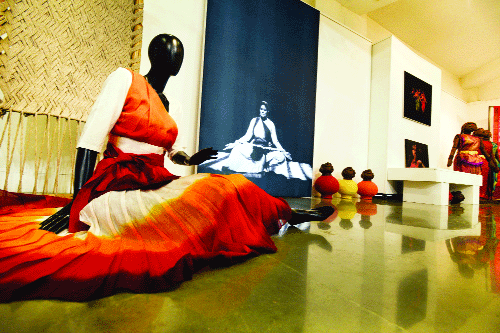Fashion designer Sandhya Raman has given an interesting twist to the traditional Bharatanatyam attire. She shares with Rupinder Kaur how she has to keep all elements of a dance act in mind apart from playing with colours and fabrics
When designer Sandhya Raman compares the pleated fan in front of a Bharatanatyam dancer’s costume with a peacock opening and closing its vibrant feathers, we immediately picture the entire attire with its exquisite large borders, the lustrous silk, the colours and of course the pajama pants with the swaying pleats.
An ongoing exhibition at the India International Centre When the Pleats Dance, curated by Raman, celebrates danseuse and Padmashri awardee Geeta Chandran’s four decades of engagement with Bharatanatyam and also the inherent element of costuming.
Raman, an alumnus of NID and a student of the first batch of apparel design, has been a part of the classical Indian dance world for the past two decades. Breaking away from the norm, with regard to the Bharatanatyam attire, is what she did after meeting Chandran.
“I was introduced to Chandran, who was completely attired and steeped in tradition, during one of her performances by another dancer Anita Ratnam. I showed her my work and she found it interesting. Also, she was at a threshold where she was a good dancer and wanted to explore other horizons. So I designed some costumes for her in a dance piece called Shringara vaibhavam, which celebrates the sensuality of the body and the naika’s (dancers) love for the divine male. What I had to keep in mind was how can I accentuate her form and give a more sensuous, elegant and a modern look,” she shares while walking with us through the exhibit.
A strong departure from her line, Raman made a huge impact in Chandran’s career by changing the look. “I was not cutting away from the traditional look but was adding the a modern angle to it,” she claims.
Raman’s interest in costume designing goes back to her first-of-its-kind project with Jonathan Hollander and Mallika Sarabhai. She recalls, “It was the first time we had a thematic fashion experience using dancers and it was really interesting. I did the fashion choreography for the entire collection.”
Over the years, Raman has worked with many renowned dancers including Anita Ratnam, Mallika Sarabhai, Sonal Mansingh, leela Samson, Vanashree Rao (Kuchipudi), Aditi Mangaldas (Kathak), et al.
Creating a dancer’s ensemble needs more than a workshop area and a few craftsmen. It is not simply about buying fabric and stitching it together, but there is much more to it which Raman shares.
A row of costumes from Chandran’s personal collection from when she was 12 or 14-years-old are also on display, which according to Raman, are ideal for the young dancers only.
“There are many things that don’t work, you can’t stretch too much or make a perfect sit. We had fabulous traditional craftsmen but unfortunately they didn’t have the training. Dance costumes need a lot of ergonomics. It’s not only aesthetics or knowing about design, history, culture and fabric but they also need to know how the body works. Dancers are very conscious about the poses, so many stereotypical psychological holds that one has to work on,” she tells us.
She also sits through the dancers’ rehearsals in order to incorporate the details in the garment which would hold the audience’s attention. A sketch or a doodle is what helps Raman give shape to the costume. Every project is a blank sheet first where she starts from scratch and steps into the next stage.
“I watch the rehearsals as an audience and not as a creative. Since your attention is flitting and moving during an act, I make sure that I try to hold it and then release it with the help of the performer’s costume. In a 60-minute recital, you’re absorbing the dance and it does get tiring but then with a sudden subtle change in costume, a new element will be brought in.
As a costume designer, I need to understand the dance form. It is very different from the mainstream fashion. There it’s my fashion line, my interpretation of the design and it is what I want to give the market but here, it is what the dance form is asking me to do, what the theme desires. I come with a blank sheet and with not any preconceived ideas that I’ll create this,” she says.
It was during Chandran’s performance of Gandhi: Warp and Weft in 2012 when Raman used khadi along with the colourful tie-and-dye borders depicting the native Gujarat of Gandhi’s childhood. She elaborates, “So I moved to the palette of blues and greens for his philosophies and a final costume of a white sari for his spiritual challenges that he struggled with.”
Not many contemporary designers can be seen collaborating with classical dancers; Raman blames it on money constraint. She says that it is important for prominent dancers to set an example for youngsters.
“First, I don’t know how many designers are interested in dance and secondly, I don’t think it’s a well-paying profession because even the dancers have budget constraints. For me, it’s a passion that I follow and in the last 25 years it has been a part of my profession. I work through a process and my team, who have been with me for 21 years, is committed and knows the tricks of the trade.
If you want good costumes, you need to pay for it. As a designer you are sensitive to the use of fabric. I tell my senior designers that I’ll use traditional fabric and you pay up for it because you are mentors and people look up to you. You have to make a statement with what you are wearing. That statement in its own way will work on the psychology of youngsters. You can titillate or sensitise them or invoke their desire to know the fabric and other elements,” she suggests.
























